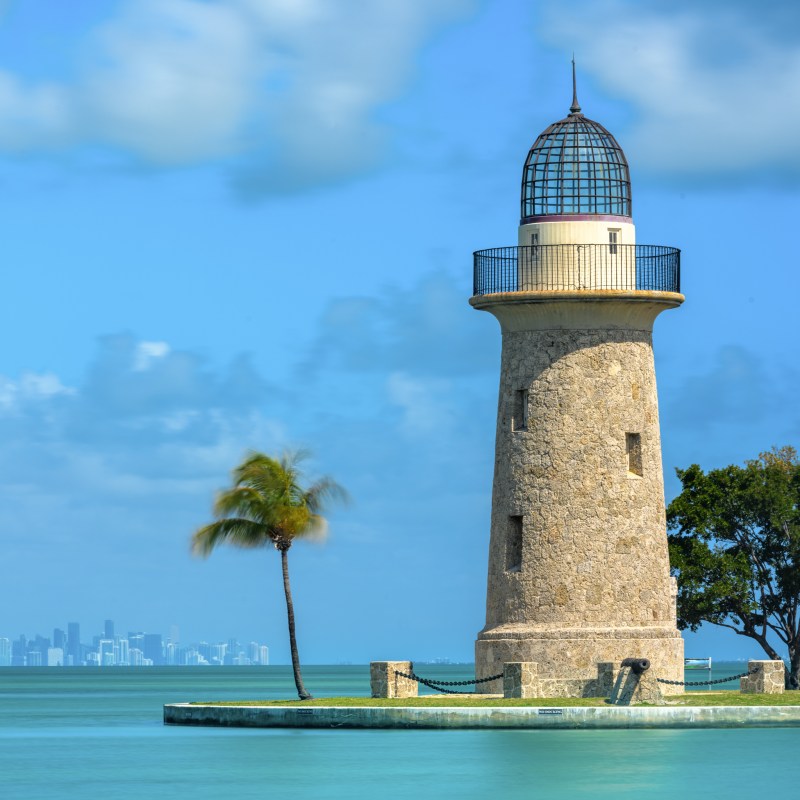
I think practically everyone I know has been to Florida. Whether the Northern areas of St. Augustine or Daytona Beach, the popular Gulf coast area, or the action-packed South Florida area, it seems everyone loves Florida! I know I do. I’ve visited Florida more times than I can count and have spent time in just about every region of Florida. From the Northern Gulf coast down to the Florida Keys, I’ve seen quite a bit of the state. I’ve looked for alligators in the Everglades, dined on conch fritters in the Keys, and hit the beach in Daytona. And it’s all been a blast. I love Florida for so many reasons. It’s a state that’s unique and diverse. On top of everything else it has to offer, did you know that Florida is home to three different national parks? Yes, there are three completely distinctive national parks in the state: the expansive Everglades, the isolated Dry Tortugas, and the water phenomenon, Biscayne National Park. While all are unique, Biscayne National Park may be the most unique national park in the United States. It’s estimated that 95 percent of the park is underwater!
Videos by TravelAwaits
Made up of four distinct marine ecosystems, including mangroves, the Keys, the Bay, and corals reefs, the park is also home to unusual wildlife like American crocodiles and peregrine falcons. Don’t let the fact that much of the park is underwater stop you from visiting. There’s plenty to do in this Florida favorite, in water or on land. And, it’s big — the Biscayne National Park is the largest marine park in the U.S, at over 172,000 acres.
The best way to get to the park is to drive. Here are the driving times from various Florida cities:
- Drive from Homestead: 20 minutes
- Drive From Miami: 1 hour
- Drive from Ft. Lauderdale: 1.5-2 hours
If you’re driving in from the North, take the Florida Turnpike. You will probably want to avoid US1 because it’s the slowest way to go.
An alternative to driving the whole way on your own is to get yourself to Homestead, then take the free trolley from Homestead. The Homestead National Parks Trolley runs every weekend from November through April. The trolley departs from downtown Homestead and drops off at the Dante Fascell Visitor Center and the Homestead Bayfront Marina.
So, when is the best time to go to Biscayne National Park? Since the park is open from 8:30 a.m. to 5:30 p.m. daily, 365 days per year, you have your choice of when to visit! The dry season in Florida is between December and April. Florida has a tropical climate and it can be quite rainy. In the summertime, it rains a lot. If you don’t like much rain, then go during the dry season. Temperature-wise, the summer months in Florida can be brutal! The weather is very hot and humid, with temperatures averaging around 90 degrees in August. In January, it’s slightly less humid and much cooler, with average temperatures around 77. So as far as the best time of year to go, it really depends on what type of weather you like.

1. Dante Fascall Visitor Center
The visitor center is located in Convoy Point, 9 miles east of Homestead, Florida. Stop in at the visitor center to get yourself acquainted with the area, and also watch one of the various short movies that take you on a virtual journey through the park. And, you can check out all the interpretive displays the center offers. In addition, the visitor center is home to the Dante Fascell Gallery, which showcases contemporary art done by artists that have visited and been inspired by the park. Boat tours take off from the visitor center here as well. Open daily from 9 to 5.
2. Boating
The park is for water lovers! Since 95 percent of the park is underwater, the vast majority of people come here to explore the water: the shipwrecks, the reefs, the sea life are just some of the things that you can explore in the waters of the park. That said, there are some land things to do as well, but there’s much more to see in the water
The best way to see the park is by boat. If you’re lucky enough to have your own boat, Biscayne National Park is the place for you! You’ll love exploring the beautiful mangroves and islands in the park. If you don’t have a boat, you can do one of the various guided boat tours offered through Biscayne National Park Institute. We recommend taking a guided boat cruise within the park to Boca Chita Island. You can select a 3-hour cruise and will have time to explore the island, climb the lighthouse on the island, and you can even swim in the shallow waters near the shore. The guides are well informed and will provide interesting information about the park, its history, and its natural habitat.

3. Snorkel And Scuba
One of the coolest features of the park is the fact that it is mostly an underwater park.
The reef separates Miami from the ocean and protects the northernmost group of living coral reefs in the United States. You’ll see mangroves and coral reefs here as well as sea turtles, dolphins, manatees, and pelicans. There is so much marine life to see here.
Biscayne National Park offers some of the best snorkeling in the country. In particular, the Maritime Heritage Trail is the ultimate spot for history-loving snorkelers. The Maritime Heritage Trail is a one-of-a-kind underwater area where you can explore over six different historic shipwrecks. It’s a premier destination for snorkelers and divers.
The Maritime Heritage Trail is the final resting spot for quite a few different shipwrecks of many eras. You can explore the remains of historic wooden ships and more recent shipwrecks. The Trail is accessible by boat, so plan on booking a guided tour with Biscayne National Park Institute. You can book a 3.5-hour tour to experience the reef, the shipwrecks, and the mangroves. You’ll be able to see tons of incredible fish and underwater sea life. The boats are rigged with shade, so you can get out of the sun if you want to. Keep in mind that these tours are very popular, so you will want to book in advance because they sell out. The adventure starts at the Biscayne National Park Headquarters at Convoy Point.
4. Paddleboarding
Another great option for exploring the water is my favorite, paddle boarding! Feel free to launch your own paddleboard near the visitor center and paddle away. If you don’t have your own board, no problem! You can hop on a tour with Biscayne National Park Institute. In addition to awesome boat tours, they offer paddle tours of the waters. You can enjoy SUP, kayaking, and canoeing, where you can explore the mangrove canals of Jones Lagoon with their Naturalists. It’s sure to be a fun, informative, and active way to explore the park! You’ll learn some history of the area as you visit the Jones Family Historic District, which includes the Porgy Key and Totten Key, where the founders of the park grew pineapples and key limes back in the 1800s.
In 1968, the area was declared a national monument and in 1980, it was declared a national park. Motivated by the belief that the area should be preserved prompted Lancelot and his sister-in-law Kathleen to sell their share of the island to the National Park Service in 1970. Made up of more than 277 acres, the National Park Service paid them 1.2 million dollars. Lancelot Jones was granted the right to live out his remaining years in the family home.

5. Camping
There are two campgrounds in the park and both are accessible only by boat. Neither takes advanced reservations. They’re both first-come, first-served. And, there are no services at either park. What this means is that if you need it, bring it with you! Each site charges a camping fee of around $25 per night, which must be paid in exact change at the kiosk when entering.
Boca Chita Key is the most popular key for camping, probably because it offers unbelievably beautiful waterfront views and offers a nice grassy camping area. Boca Chica also has picnic tables and grills for your dining pleasure! There are toilet facilities at Boca Chita but no showers or water. Be sure to check out the famed Boca Chica lighthouse!
Elliott Key is another popular camping spot within the park. Elliott Key is the park’s largest island and offers camping amenities like restrooms with sinks and cold water showers along with picnic tables and grills. Drinking water is also available here, but it’s suggested to bring your own in case the system goes down.
The third Key, Adam’s Key, isn’t open for camping, but it is open for day trips. You can stop by to check out this famed island where multiple former presidents such as Hoover, Johnson, and Nixon liked to visit.
No matter how you choose to spend your time in the park, make sure you take plenty of sunscreen and water; and enjoy exploring this fabulous park!
Related articles:
